How to remove ScoringMathTea remote access trojan
TrojanAlso Known As: ScoringMathTea remote access trojan
Get free scan and check if your device is infected.
Remove it nowTo use full-featured product, you have to purchase a license for Combo Cleaner. Seven days free trial available. Combo Cleaner is owned and operated by RCS LT, the parent company of PCRisk.com.
What kind of malware is ScoringMathTea?
ScoringMathTea is a Remote Access Trojan (RAT) written in the C++ programming language. It is a sophisticated malicious program with an emphasis on stealth and evasion of detection. RATs are designed to enable remote access/control over compromised machines. ScoringMathTea has been developed and is used by Lazarus – a threat actor group aligned with the North Korean state.

ScoringMathTea malware overview
ScoringMathTea is a remote access trojan that allows attackers to access and control devices remotely. Two different infection chains have been observed for this malware.
One of the chains is jumpstarted with victims running a legitimate executable that side-loads a dropper. This technique is called DLL side-loading – it entails the Windows DLL search order mechanism being utilized to leverage a genuine application for executing the malicious payload. The side-loaded dropper introduces BinMergeLoader and ScoringMathTea into systems.
The other chain begins with a dropper that drops a loader, which loads an encrypted data file. Upon decryption, this file loads ScoringMathTea in-memory. Relying on in-memory execution enhances the RAT's stealth, as this makes it undetectable for certain security products. This trojan boasts strong code obfuscation as well.
ScoringMathTea is a versatile RAT that can execute various commands and relies on downloaded plug-ins to expand its capabilities. The plug-ins are also loaded in-memory. The exact plug-ins and their functionalities are unknown; they are likely to vary between infections.
Based on Lazarus' activities (ScoringMathTea's developer/operator) that center on cyber-espionage, it is expected that the additional features utilized by ScoringMathTea will relate to spying and data theft.
These abilities could include recording audio/video via microphones/cameras, taking screenshots, recording/live-streaming desktops, stealing files, keylogging (recording keystrokes), extracting/exfiltrating data from apps (e.g., browsers, email clients, messengers, FTP clients, VPNs, password managers, cryptocurrency wallets, etc.), tracking/collecting clipboard (copy-paste buffer) contents, and so on.
It is likewise worth mentioning that malware developers often improve upon their software and methodologies. Therefore, Lazarus could implement additional/different functionalities in potential future iterations of ScoringMathTea.
In summary, the presence of malicious software like ScoringMathTea on devices can lead to severe privacy issues, financial losses, and identity theft. It is noteworthy that malware leveraged against high-sensitivity targets can pose risks of even greater significance.
| Name | ScoringMathTea remote access trojan |
| Threat Type | Trojan, Remote Access Trojan, Remote Administration Tool, RAT. |
| Detection Names | Avast (Win32:Agent-BDQL [Drp]), Combo Cleaner (Trojan.GenericKD.76311150), ESET-NOD32 (Win64/NukeSped.QK Trojan), Kaspersky (Trojan.Win64.Lazarus.et), Microsoft (Trojan:Win64/NukeSped.GXF!MTB), Full List Of Detections (VirusTotal) |
| Symptoms | Trojans are designed to stealthily infiltrate the victim's computer and remain silent, and thus no particular symptoms are clearly visible on an infected machine. |
| Distribution methods | Infected email attachments, malicious online advertisements, social engineering, software 'cracks'. |
| Damage | Stolen passwords and banking information, identity theft, the victim's computer added to a botnet. |
| Malware Removal (Windows) |
To eliminate possible malware infections, scan your computer with legitimate antivirus software. Our security researchers recommend using Combo Cleaner. Download Combo CleanerTo use full-featured product, you have to purchase a license for Combo Cleaner. 7 days free trial available. Combo Cleaner is owned and operated by RCS LT, the parent company of PCRisk.com. |
Remote access trojan examples
We have written about countless malicious programs; PatoRAT, STD RAT, Minecraft RAT, UwUdis, Propionanilide, and Atroposia are merely some of our latest articles on RATs.
Remote access trojans can be incredibly multifunctional, and this is true of many malware types. However, malicious software can be designed for a specific and limited purpose. Yet regardless of how malware operates – its presence on a system endangers device integrity and user safety. Therefore, all threats must be removed immediately upon detection.
How did ScoringMathTea infiltrate my computer?
It is currently unknown exactly how ScoringMathTea is distributed. Generally, malware is spread by relying on phishing and social engineering techniques. Malicious software is often disguised as or bundled with ordinary content.
Virulent files come in different formats, such as archives (ZIP, RAR, etc.), executables (.exe, .run, etc.), documents (Microsoft Office, Microsoft OneNote, PDF, etc.), JavaScript, and others. The infection chain is triggered once a malicious file is executed, run, or otherwise opened.
Malware is primarily distributed via trojans (loaders/backdoors), malicious attachments or links in spam emails/messages, online scams, malvertising, untrustworthy download sources (e.g., freeware and free file-hosting websites, P2P sharing networks, etc.), drive-by (stealthy/deceptive) downloads, pirated programs/media, illegal software activation tools ("cracks"), and fake updates.
Furthermore, some malicious programs can self-proliferate through local networks and removable storage devices (e.g., external hard drives, USB flash drives, etc.).
How to avoid installation of malware?
We highly recommend being cautious while browsing, as the Internet is rife with fake and malicious content. Incoming emails and other messages must be approached with care. Attachments or links present in suspicious/irrelevant communications must not be opened, as they can be infectious.
Another recommendation is to download only from official and verified channels. Additionally, all programs must be activated and updated using legitimate functions/tools, as those acquired from third-parties can contain malware.
It is paramount to have a reputable antivirus installed and kept up-to-date. Security software must be used to run regular system scans and to remove active and potential threats. If you believe that your computer is already infected, we recommend running a scan with Combo Cleaner Antivirus for Windows to automatically eliminate infiltrated malware.
Instant automatic malware removal:
Manual threat removal might be a lengthy and complicated process that requires advanced IT skills. Combo Cleaner is a professional automatic malware removal tool that is recommended to get rid of malware. Download it by clicking the button below:
DOWNLOAD Combo CleanerBy downloading any software listed on this website you agree to our Privacy Policy and Terms of Use. To use full-featured product, you have to purchase a license for Combo Cleaner. 7 days free trial available. Combo Cleaner is owned and operated by RCS LT, the parent company of PCRisk.com.
Quick menu:
- What is ScoringMathTea?
- STEP 1. Manual removal of ScoringMathTea malware.
- STEP 2. Check if your computer is clean.
How to remove malware manually?
Manual malware removal is a complicated task - usually it is best to allow antivirus or anti-malware programs to do this automatically. To remove this malware we recommend using Combo Cleaner Antivirus for Windows.
If you wish to remove malware manually, the first step is to identify the name of the malware that you are trying to remove. Here is an example of a suspicious program running on a user's computer:
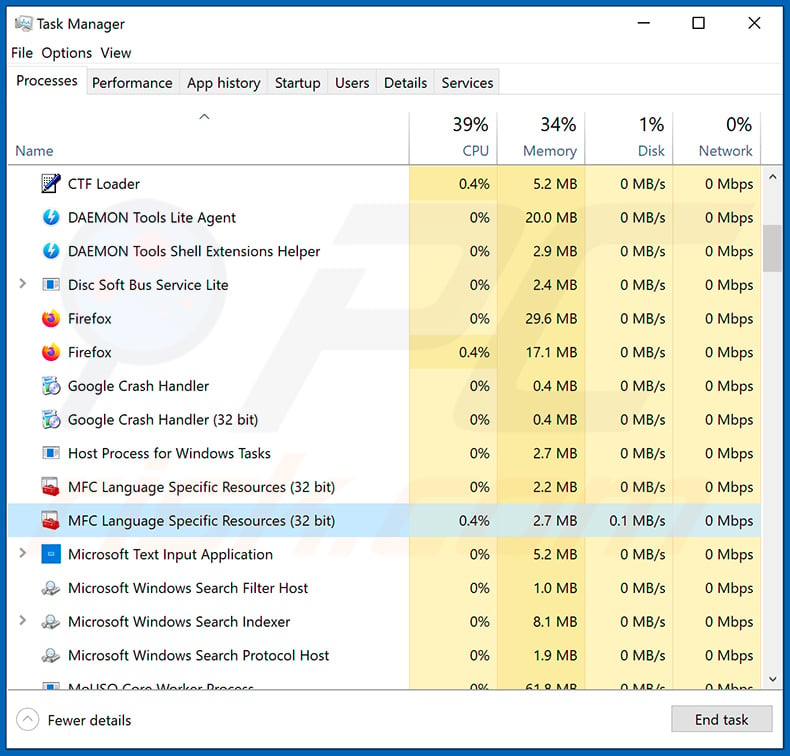
If you checked the list of programs running on your computer, for example, using task manager, and identified a program that looks suspicious, you should continue with these steps:
 Download a program called Autoruns. This program shows auto-start applications, Registry, and file system locations:
Download a program called Autoruns. This program shows auto-start applications, Registry, and file system locations:
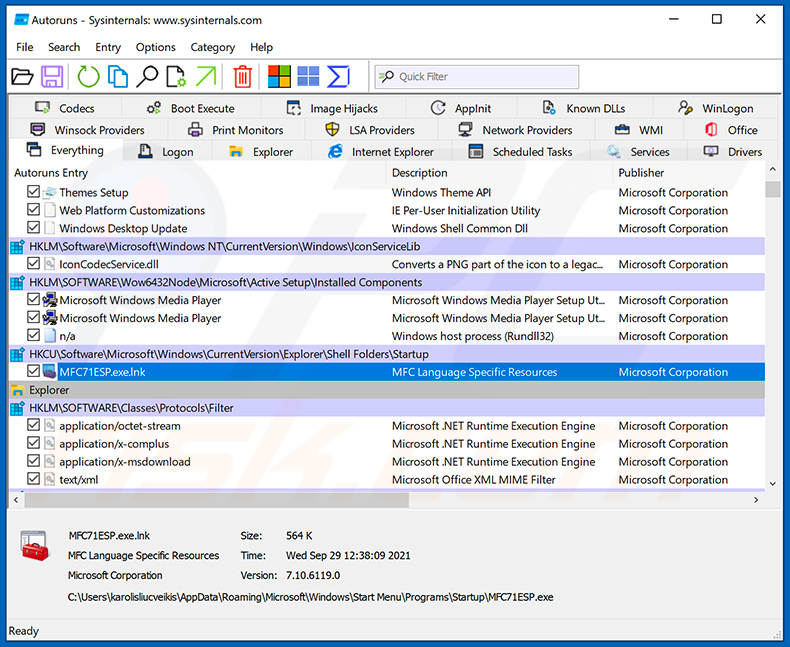
 Restart your computer into Safe Mode:
Restart your computer into Safe Mode:
Windows XP and Windows 7 users: Start your computer in Safe Mode. Click Start, click Shut Down, click Restart, click OK. During your computer start process, press the F8 key on your keyboard multiple times until you see the Windows Advanced Option menu, and then select Safe Mode with Networking from the list.
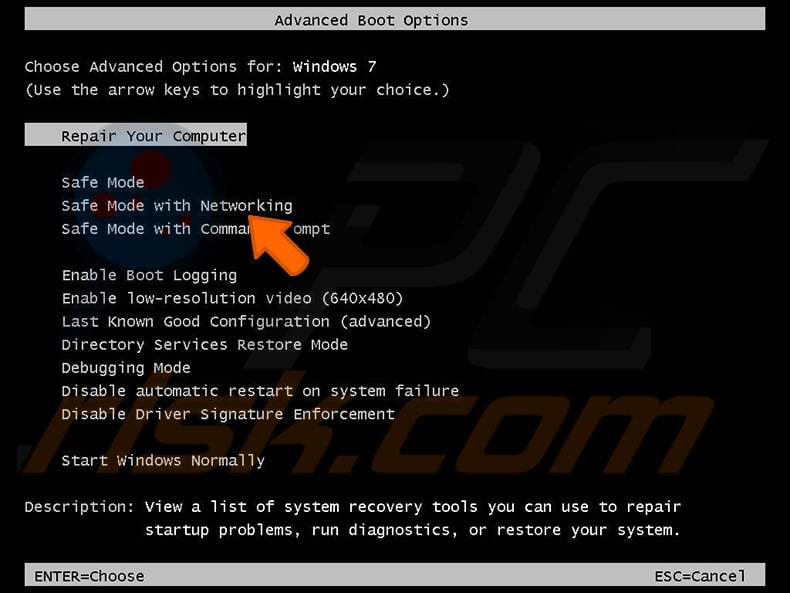
Video showing how to start Windows 7 in "Safe Mode with Networking":
Windows 8 users: Start Windows 8 is Safe Mode with Networking - Go to Windows 8 Start Screen, type Advanced, in the search results select Settings. Click Advanced startup options, in the opened "General PC Settings" window, select Advanced startup.
Click the "Restart now" button. Your computer will now restart into the "Advanced Startup options menu". Click the "Troubleshoot" button, and then click the "Advanced options" button. In the advanced option screen, click "Startup settings".
Click the "Restart" button. Your PC will restart into the Startup Settings screen. Press F5 to boot in Safe Mode with Networking.

Video showing how to start Windows 8 in "Safe Mode with Networking":
Windows 10 users: Click the Windows logo and select the Power icon. In the opened menu click "Restart" while holding "Shift" button on your keyboard. In the "choose an option" window click on the "Troubleshoot", next select "Advanced options".
In the advanced options menu select "Startup Settings" and click on the "Restart" button. In the following window you should click the "F5" button on your keyboard. This will restart your operating system in safe mode with networking.
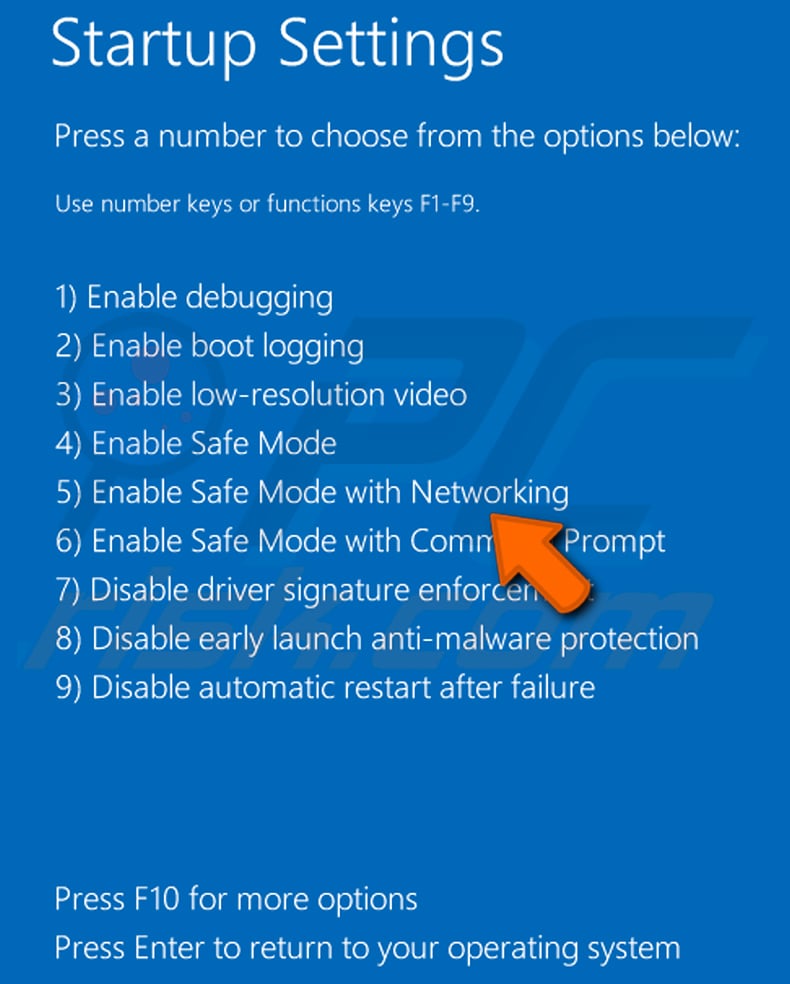
Video showing how to start Windows 10 in "Safe Mode with Networking":
 Extract the downloaded archive and run the Autoruns.exe file.
Extract the downloaded archive and run the Autoruns.exe file.

 In the Autoruns application, click "Options" at the top and uncheck "Hide Empty Locations" and "Hide Windows Entries" options. After this procedure, click the "Refresh" icon.
In the Autoruns application, click "Options" at the top and uncheck "Hide Empty Locations" and "Hide Windows Entries" options. After this procedure, click the "Refresh" icon.

 Check the list provided by the Autoruns application and locate the malware file that you want to eliminate.
Check the list provided by the Autoruns application and locate the malware file that you want to eliminate.
You should write down its full path and name. Note that some malware hides process names under legitimate Windows process names. At this stage, it is very important to avoid removing system files. After you locate the suspicious program you wish to remove, right click your mouse over its name and choose "Delete".

After removing the malware through the Autoruns application (this ensures that the malware will not run automatically on the next system startup), you should search for the malware name on your computer. Be sure to enable hidden files and folders before proceeding. If you find the filename of the malware, be sure to remove it.
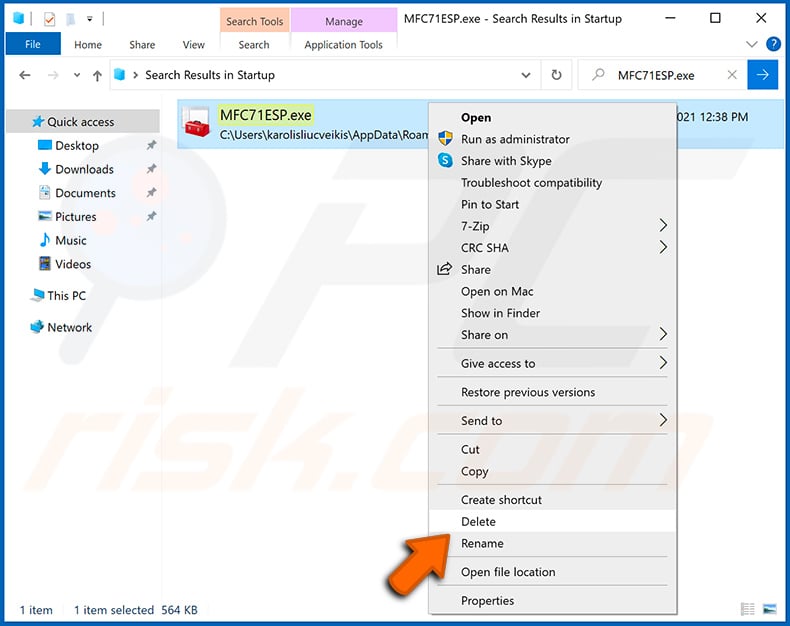
Reboot your computer in normal mode. Following these steps should remove any malware from your computer. Note that manual threat removal requires advanced computer skills. If you do not have these skills, leave malware removal to antivirus and anti-malware programs.
These steps might not work with advanced malware infections. As always it is best to prevent infection than try to remove malware later. To keep your computer safe, install the latest operating system updates and use antivirus software. To be sure your computer is free of malware infections, we recommend scanning it with Combo Cleaner Antivirus for Windows.
Frequently Asked Questions (FAQ)
My computer is infected with ScoringMathTea malware, should I format my storage device to get rid of it?
Malware removal rarely necessitates formatting.
What are the biggest issues that ScoringMathTea malware can cause?
The dangers associated with an infection depend on the malware's capabilities and the attackers' modus operandi. ScoringMathTea is a stealthy RAT that enables remote access/control over devices and relies on plug-ins to expand its functionality. Generally, infections of this kind can lead to serious privacy issues, financial losses, and identity theft.
What is the purpose of ScoringMathTea malware?
ScoringMathTea was developed and is used by Lazarus – a threat actor group aligned with the government of North Korea. Hence, attacks involving this RAT are likely to have political/geopolitical motivations.
It is worth mentioning that the most common reason for malware infections is financial gain. Other motivations include the attackers seeking amusement or personal vendettas, process disruption (e.g., sites, services, companies, organizations, etc.), and hacktivism.
How did ScoringMathTea malware infiltrate my computer?
Malware is primarily proliferated through trojans, drive-by downloads, malvertising, spam emails/messages, online scams, suspicious downloaded channels (e.g., unofficial and free file-hosting websites, P2P sharing networks, etc.), pirated content, fake updaters, and illegal software activation ("cracking") tools. Some malicious programs can self-spread via local networks and removable storage devices.
Will Combo Cleaner protect me from malware?
Combo Cleaner can detect and remove almost all known malware infections. It must be stressed that running a full system scan is crucial since high-end malicious programs typically hide deep within systems.
Share:

Tomas Meskauskas
Expert security researcher, professional malware analyst
I am passionate about computer security and technology. I have an experience of over 10 years working in various companies related to computer technical issue solving and Internet security. I have been working as an author and editor for pcrisk.com since 2010. Follow me on Twitter and LinkedIn to stay informed about the latest online security threats.
PCrisk security portal is brought by a company RCS LT.
Joined forces of security researchers help educate computer users about the latest online security threats. More information about the company RCS LT.
Our malware removal guides are free. However, if you want to support us you can send us a donation.
DonatePCrisk security portal is brought by a company RCS LT.
Joined forces of security researchers help educate computer users about the latest online security threats. More information about the company RCS LT.
Our malware removal guides are free. However, if you want to support us you can send us a donation.
Donate
▼ Show Discussion